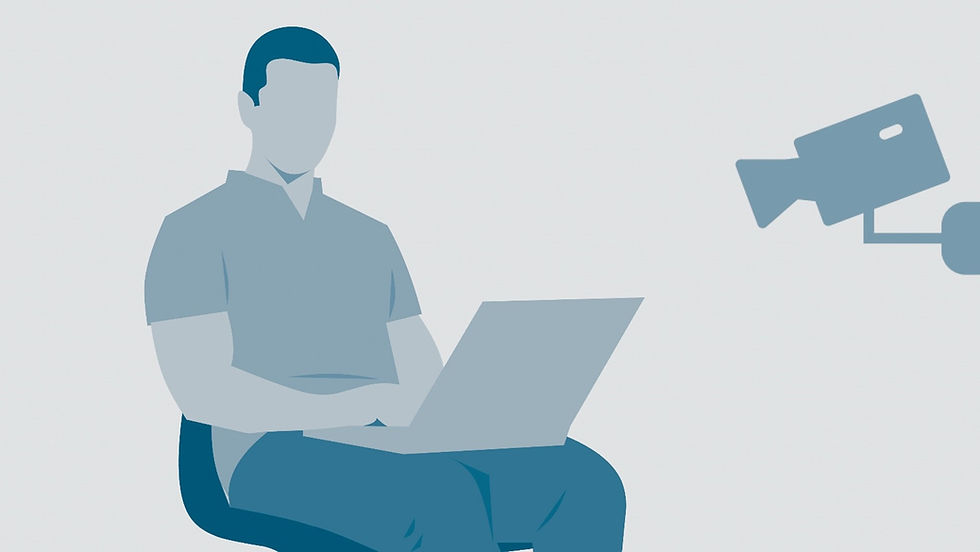Recorded Lectures - What Do the Rules Say?
- Esset Samhällsbyggnad

- 26 apr. 2021
- 5 min läsning

The transition to home studies through Zoom made it possible overnight for teachers to easily record their lectures. For students this was a welcome aid in an unprecedented situation, with the obvious advantage of being able to go back and repeat certain parts of a course. But during the year that’s passed, it has become apparent that there are a lot of factors to consider before pressing the record button. Esset therefore decided to try and find out what rules that actually apply.
During the first lecture of a new course there are always a few administrative questions to work out. When Zoom made its entry this became all the more obvious, while at the same time it added a few more factors to consider. One year later most of these issues have been resolved, but one question still splits the teachers of KTH – how to handle the recording of lectures.
In every course I take, different rules seem to apply. When we started to study from home about a year ago, you could sense – despite all of the serious events going on in the outside world – a bit of enthusiasm related to the opportunities presented by the new technology. All of Zoom’s functionalities were tested extensively, as every lecture was filled to the brim with polls and discussions in breakout rooms. Naturally, every lecture was recorded as well – we have the technology!
But as we returned after the summer break, it seemed like the honeymoon phase was over. Bureaucratic issues had surfaced, and students asking for lectures to be recorded were denied with the explanation of GDPR. The good times seemed to be over for now. Therefore the second study period came as a bit of a surprise, when the lectures in one of my courses were to be recorded. In the other course however, the lecturer kept insisting that recording was prohibited, despite the students’ best efforts to convince them otherwise. After christmas the situation has been similar – recorded lectures in some courses, no recordings in others.
What should we expect as students? In order to get a better understanding of the different policies that obviously exist around KTH, Esset sent out a poll to some 20 different division heads (mainly part of the ABE school, but also some others, such as mathematics). Among those who responded, an overwhelming majority said that it was up to the course responsible teacher to decide if lectures should be recorded. Only a few responded that there was a division-wide policy for how to handle the issue of recording, which greatly explains all of the different opinions that we as students meet.
Not surprisingly, the most common reason for recording lectures stated by those who do so was that they do it in order to aid the students with their learning. Some questioned however if any student actually sits down and looks through an entire recording, and wondered if shorter clips related to specific topics perhaps would be more effective. Another reason mentioned was that it was seen as convenient to have the lectures recorded, so that they could be used in case of illness in the future.
As mentioned earlier, GDPR is sometimes stated as the reason for lectures not being recorded. But obviously, some teachers still record their lectures. So what’s the deal then concerning GDPR? First some short background: The legislation GDPR (short for General Data Protection Regulation) was introduced in the European Union back in 2018, with the purpose of regulating the treatment of personal data, so as to not violate the integrity of any individual. When a Zoom lecture is recorded, the names of those present are registered, and in some cases also their voices and appearances. GDPR then says that everyone present must agree to the collection of this personal data, and that they have the right to know the purpose of the collection as well as how the data is stored.
During the past year concerns about safety regarding Zoom have been raised, mainly with respect to suspected ties to the Chinese government. But the version of Zoom that is used at KTH is separate from the rest of the software, and basically only has the interface in common with the “real” version. Instead, the video conferencing service is supplied by an organization called NORDUnet, whose task is to provide network services to research and educational institutions in the Nordic countries. Their servers are located in Stockholm and Copenhagen, and according to themselves the version of Zoom that they supply is fully GDPR compliant. Permission to collect personal data is handled by requiring all participants to consent to recording in order to stay in the meeting.

But the main issue concerning GDPR is perhaps not the act of recording itself, but rather what happens to the file afterwards. The regulation also states that personal data only can be stored as long as it is necessary, and that the organisation that collects the data is responsible to make sure that it can not be accessed by unauthorized individuals. What is it that you actually agree to by pressing “Continue” in the dialogue box above? Most people would probably be OK with the recording being uploaded to the course Canvas page, so that it could be viewed by their coursemates. But have you also agreed to the recording being uploaded to the Canvas page for those taking the course in future years? Legally it is hard to motivate keeping the personal data for that purpose. Another possible scenario is if a student downloads the recording and then uploads it to for example Youtube. Perhaps not very likely, but such a case could result in hefty fines for KTH, meaning that the uploading of recordings to Canvas brings with it some risk.
Even though some teachers that do not record their lectures mention GDPR as a contributing factor, the most common reason is the desire for students to participate “live” during lectures. These teachers share the view on lectures as an occasion not only for the lecturer to share their knowledge, but also as an opportunity for dialogue with the students – active participation through questions and discussions. In their opinion, a digital lecture should try to emulate its physical counterpart as closely as possible. A normal lecture held on KTH campus is never recorded, so why would you start doing that now just because it has been moved to Zoom? Sure, it is more simple to record now, but the main advantage of recording – being able to watch the lecture at a later time – is in direct conflict with the purpose of lectures according to these teachers. The risk of reduced student participation if you do not have to be present at the time of the lecture is obvious.
What conclusions can be drawn regarding the issue of recording? When it comes to GDPR, there are no simple answers. The act of recording itself seems to be fine from a legal perspective, and is definitely appreciated by students. The problems arise when handling the recording afterwards, where there are some risks of GDPR violation.
Besides GDPR, it is obvious that both those who record their lectures and those who do not have formed their opinion based on what they believe is best for students’ learning. It is hard to measure who is in the right, and it can also be done in several ways. Which student has had the “best learning”? Is it the one who remembers the most about the topic of the lecture, or perhaps the one who gets the highest grade on the final exam? How students’ learning has been impacted by studying from home will surely be the topic of countless research papers in the coming years, and the way an individual feels is the best way to learn may not be the most effective. For example, a recent study came to the shocking conclusion that lofi hip hop music - beats to relax/study to is not good to listen to while you study. Until researchers have caught up, we will have to accept that teachers’ opinions on recording differ, and – like so many other aspects of studying from home – make the best of the situation.
Andreas Håård
Writer











Kommentarer